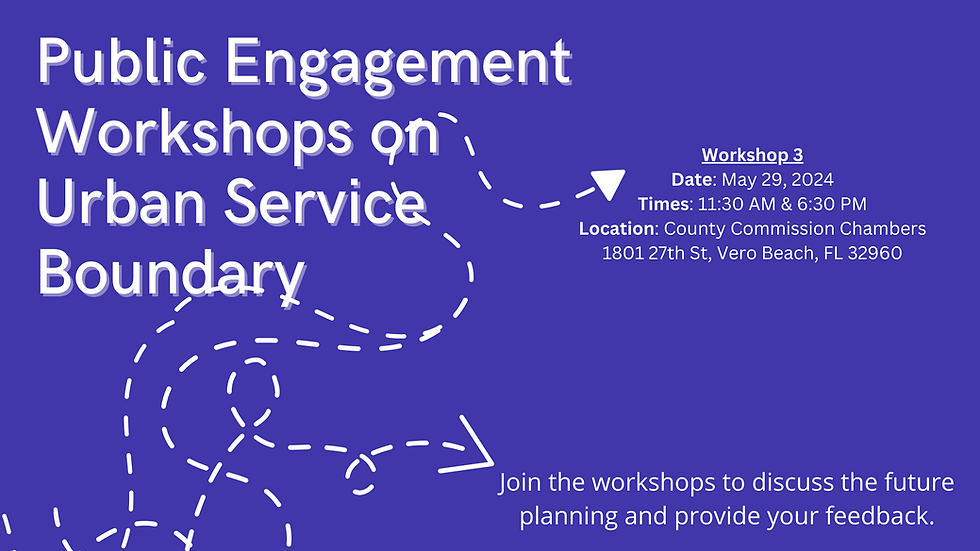May Newsletter
- CWC
- May 24, 2024
- 4 min read

Last mentioned in our August 2023 Newsletter, the Anchoring Limitation Area (ALA) is making steady progress! Currently, the Cities of Sebastian, Vero Beach and the Town of Indian River Shores are working with Indian River County to establish and enforce areas of the Lagoon where anchoring will be limited to 45 days within a six-month period. Former County Commissioner Peter O’Bryan introduced the ALA concept at CWC’s request about two years ago.
The Indian River Lagoon is a delicate and irreplaceable ecosystem. The CWC recognizes that even cherished pastimes like boating can have unintended consequences. Extended anchoring contributes pollution from overboard discharge of waste. Long-term anchored boats can become abandoned or derelict vessels, posing significant environmental and navigational challenges. Through implementation of the ALA, it is expected that those problems will be addressed earlier avoiding costly expense for removal.
Proposed ALAs are strategically situated in popular anchoring areas in Sebastian, Indian River Shores, and Vero Beach. These areas will be clearly marked with signage and buoys to inform boaters of the new regulations.
The CWC firmly believes that Indian River County's proactive approach to balancing recreation and conservation can serve as a model for other coastal communities. By implementing the ALA, we can protect this invaluable resource while ensuring that boaters can continue to experience the beauty and wonder of the Indian River Lagoon.

ONE WAY TO HELP THE LAGOON
By Jean Catchpole. This letter appeared in the Press Journal. CWC Board Member Jean Catchpole gave us permission to post.
People are always asking, “What can we do to help the lagoon?” Observing the upcoming fertilizer ban is an opportunity to do so.
All residents of Indian River County, Sebastian, City of Vero Beach, Indian River Shores and Orchid are subject to a local ban that starts June 1st and ends September 30th. It coincides with the start of our rainy season when more nutrients such as the nitrogen and phosphorous in fertilizer are likely to be washed from our lawns, driveways and roads into the storm water system and, ultimately, into our local waters such as the Indian River Lagoon. These excess nutrients are the fuel for toxic algae blooms that impair marine life and human health.
No fertilizer containing Phosphorous is to be used anytime. All fertilizers must contain at least 50% slow release Nitrogen. If your community uses reuse water for irrigation, no fertilizer is ever necessary as there are ample nutrients already in the reuse water. Finally, no fertilizer is to be applied within 10 feet of any water body and grass clippings are not to be blown into storm drains, canals, the lagoon or onto roadways.
If you or your association uses a lawn care provider, please discuss these regulations with them. For details regarding the ordinance and fertilizing tips, please see www.ircgov.com or email Alexis Peralta, the County’s Storm water educator and fertilizer enforcement officer, at aperalta@ircgov.com.
Complying with the fertilizer ordinance and reporting any violators is one way we can all personally contribute to cleaning up our local waters.
Florida's coastal beauty is undeniable, but its shorelines face constant challenges from erosion, development and environmental pressures. Thankfully, a natural solution is gaining ground – living shorelines.
Living shorelines are a sustainable approach to shoreline management that harness the power of nature to stabilize the coast and enhance the ecosystem. In fragile ecosystems like the Indian River Lagoon, they play a vital role for protection and restoration.
The Riverside Park living shoreline project, a collaborative effort between the City of Vero Beach, the Ocean Research & Conservation Association (ORCA), and dedicated volunteers from St. Edwards School showcases the innovative use of oyster reef ball modules. These modules not only provide structural support but also foster a thriving habitat for marine life.
To ensure the long-term success of this project, trained volunteers from ORCA conduct regular monitoring. This citizen science initiative collects valuable data on water quality, biodiversity, and the overall health of the living shoreline.
Living shorelines offer a sustainable and effective way to protect our precious waterways. Learn more about how you can get involved and support these vital projects here: www.TeamORCA.org.

Florida Right to Clean Water: A Renewed Effort for 2024
The Florida Right to Clean Water is a citizen-led initiative aiming to establish a constitutional amendment that guarantees Floridians the right to clean and healthy waters. Though not on the 2024 ballot, the campaign is actively gathering signatures to qualify for a future election.If you signed the petition before 2024, your signature is no longer valid.
The Florida Right to Clean Water urges all supporters to re-sign the petition to help reach the required number of verified signatures to get the amendment on a future ballot. Visit their website, floridarighttocleanwater.org, to learn more about the initiative and to sign the petition.

The Clean Water Coalition of Indian River County is pleased to welcome Dr. Marcel Barbier and Michael Sole to our board. Their dedication to environmental advocacy and community involvement makes them valuable additions to our team.
We're eager to see the new perspectives and energy Marcel and Mike will bring to the CWC. Their contributions are vital to our mission of promoting clean water and thriving ecosystems in Indian River County.

There is still time to make your voice heard at the Urban Service Boundary Workshops! Help plan the future of Indian River County growth and development with the last workshop on May 29th at the County Commission Chambers. If you haven't been to a workshop, you should go!





Comments